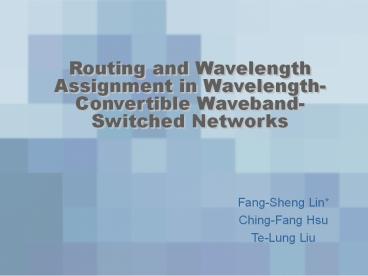Routing and Wavelength Assignment in Wavelength-Convertible Waveband-Switched Networks PowerPoint PPT Presentation
Title: Routing and Wavelength Assignment in Wavelength-Convertible Waveband-Switched Networks
1
Routing and Wavelength Assignment in
Wavelength-Convertible Waveband-Switched Networks
Routing and Wavelength Assignment in
Wavelength-Convertible Waveband-Switched Networks
- Fang-Sheng Lin
- Ching-Fang Hsu
- Te-Lung Liu
2
Outline
- Introduction
- Related Work
- Reconfigurable MG-OXC architecture
- Waveband Assignment with Path-Graph (WAPG)
algorithm - The Proposed Scheme
- Problem Definition
- Least-Configuration with Bounded Conversion
(LCBC) algorithm - Performance Evaluation
- Conclusions
3
Introduction (1/5)
- Owning to the development of DWDM systems, the
number of wavelengths gets larger and larger. - Traditional OXCs which switch traffic only at
wavelength granularity will need a great deal of
wavelength ports. - higher complexity
- difficulty associated with controlling and
management of such large OXCs
4
Introduction (2/5)
- The main idea of Waveband Switching (WBS) is to
aggregate a set of wavelengths into a band and
switch the band using a single port whenever
possible.
5
Introduction (3/5)
- The wavelength continuity constraint on
lightpath establishment existing in wavelength
routed networks also apply to WBS networks. - One possible way to relax the wavelength
continuity constraint is to use wavelength
converters at the switching node.
6
Introduction (4/5)
- It is more practical and cost-effective to share
a set of limited range wavelength converters at
each node.
7
Introduction (5/5)
- Focused on sub-path grouping strategy, we
proposed a new heuristic algorithm to solve the
dynamic RWA problem of wavelength-convertible WBS
networks efficiently.
8
Related Work (1/4) - Reconfigurable MG-OXC
- The Multi-granular Optical Cross-Connect (MG-OXC)
architecture with wavelength conversion bank 1
9
Related Work (2/4) - Reconfigurable MG-OXC
- There is a unique issue related to using
wavelength converters - In WBS networks, an instantiation of wavelength
conversion requires all wavelengths in a waveband
to be de-multiplexed and results in extra ports
consumption. - Hence, inefficient banding and employment of
wavelength converters may cause more blocking of
future requests due to the limitation of the OXC
ports.
10
Related Work (3/4) - WAPG algorithm
- The authors in 1 proposed a heuristic algorithm
called Waveband Assignment with Path-Graph (WAPG)
to address the effect on the blocking performance
and efficient usage of wavelength converters in
WBS networks.
11
Related Work (4/4) - WAPG algorithm
- WAPG
- Find out a wavelength-continuous path similar
First-Fit algorithm first. - If no wavelength-continuous path can be found,
find a non-wavelength-continuous path using
minimum number of converters. - However, it may cause undesired port usage.
12
The Proposed Scheme (1/5) - Problem definition
- The network topology
- G(V, E)
- Each fiber link has W wavelengths, which are
partitioned into B uniform wavebands. - According to the index continuity, a fixed number
K of wavelengths are chosen to be grouped into a
band
13
The Proposed Scheme (2/5) - Problem definition
- For the wavelength-convertible WBS networks, the
major objectives of dynamic RWA problem include - to minimize the configuration (switching) cost,
i.e., the total number of ports used, - to utilize wavelength conversion in a most
efficient manner, and - to achieve a magnificent network performance at
the same time.
14
The Proposed Scheme (3/5) - Least-Configuration
with Bounded Conversion
- We proposed a new heuristic algorithm, called
Least-Configuration with Bounded Conversion
(LCBC), based on - the fixed routing algorithm,
- the layered graph approach, and
- a well-designed cost function
15
The Proposed Scheme (4/5) - Least-Configuration
with Bounded Conversion
.
An illustration of layered graph modeling
16
The Proposed Scheme (5/5) - Least-Configuration
with Bounded Conversion
- The proposed cost function
Wavelength conversion degree
The weight factor
The extra port consumption at node v while ? is
the input channel and ?' is the output channel
9
Link capacity
?
0, no wavelength conversion performed
1, wavelength conversion occurred
17
Performance Evaluation (1/4)
- USAnet
- 46 nodes and 76 links.
- Every node is assumed to be a MG-OXC.
- Adopting the share-per-node architecture
- 25 wavelengths converters per node
18
Performance Evaluation (2/4)
- Traffic pattern
- A Poisson process with mean ?
- Exponentially distributed connection duration
time whose mean is 1 time unit - All existing connections can not be rearranged.
19
Performance Evaluation (3/4)
93.8
3.8
ß vs. blocking probability (W80, K10)
20
Performance Evaluation (4/4)
Blocking probability vs. arrival rate (W80,
K10, ß0.75)
21
Conclusions (1/2)
- In this paper, we proposed a heuristic algorithm,
named LCBC, to solve the problem of dynamic RWA
in wavelength-convertible WBS networks. - Adopting fixed routing as the routing selection
algorithm, we transform the wavelength selection
problem into an equivalent shortest-path problem
in an auxiliary graph. - Moreover, we proposed a cost function to
calculate an appropriate weight to each edge,
such that limited resource, including BTW/WTB
ports and wavelength converters, could be
utilized more efficiently.
22
Conclusions (2/2)
- To investigate the efficiency, we developed the
simulation to observe the performance of LCBC and
that of WAPG with various ß, and conversion
degree. - LCBC can achieve much significant blocking
performance gain.
23
Thank you!

